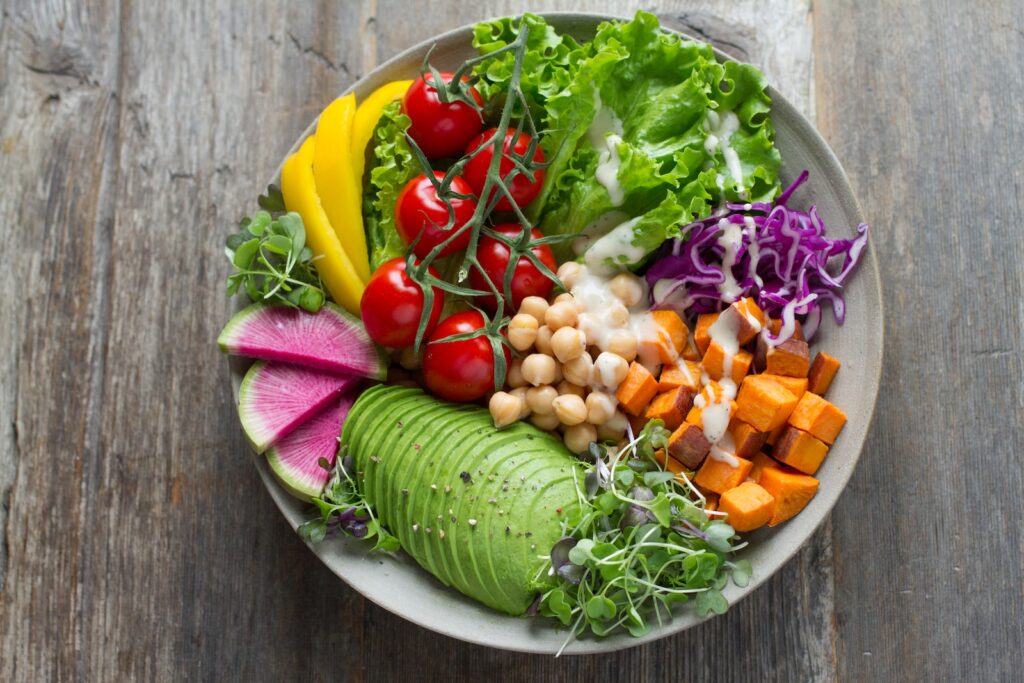While the exact causes of seborrheic dermatitis remain unclear, various factors such as age, gender, preexisting medical conditions, and even genetics may play a role in developing the condition. Some people, including me, propose that your diet plays a major role in Seb Derm control as well.
Only a few small studies have aimed to determine whether specific dietary patterns or vitamin deficiencies are related to the prevalence of seb derm. However, we know nutrition is a major component of good skin health and a well-regulated immune system.
Let’s delve deeper into the potential connection between seborrheic dermatitis and diet, review the relevant research, and dietary changes that may help alleviate your Seb Derm symptoms.
Dietary Factors Influencing Seborrheic Dermatitis

Role of Nutritional Deficiencies
Nutritional deficiencies can play a part in the development or exacerbation of seborrheic dermatitis. Ensuring a balanced diet with sufficient vitamins and minerals is crucial for maintaining healthy skin. Some of the key vitamins associated with good skin health include vitamin B6, vitamin B3, and biotin. Zinc is a mineral that may also influence seborrheic dermatitis, as low levels have been found in people with seb derm.
Impact of Fatty Acids and Inflammation
Fatty acids have a significant impact on inflammation, which may influence seborrheic dermatitis. Omega-3 fatty acids, found in foods like fish, nuts, and seeds, are known for their anti-inflammatory properties. On the other hand, omega-6 fatty acids, commonly found in vegetable oils and processed foods, can promote inflammation when consumed in excessive amounts. Balancing the intake of these fatty acids can help reduce inflammation and potentially improve seb derm symptoms.
Further reading: Is fish oil good for seborrheic dermatitis?
Gut-Skin Connection
The gut and skin have a close connection, and an imbalanced gut microbiome can negatively impact skin health. Keeping your gut healthy by consuming probiotic-rich foods such as yogurt, kefir, and kimchi may help maintain a balanced skin microbiome. A diet high in fiber from whole grains, fruits, and vegetables can support a healthy gut environment.
Food Intolerances and Allergies
Food intolerances and allergies can worsen seborrheic dermatitis. Identifying and avoiding potential trigger foods, such as gluten, dairy, or sugar may help alleviate symptoms.
Research Findings on Diet and Seborrheic Dermatitis
Clinical Studies and Observations
Sadly I found lots of dietary studies on other skin conditions but only two studies in Seb Derm worth mentioning. This cross-sectional study found a higher fruit intake was associated with a lower risk of seborrheic dermatitis, while adherence to a “Western” dietary pattern in females was associated with a higher risk of the skin condition.
Another complicated case-control and case-crossover study found a potential link between recent (less than 1 month ago) alcohol consumption and Seb Derm flare. This study wasn’t solely focused on diet so we need to interpret this finding with care. In other words, take it with a grain of salt.
Controversies and Debates
While this finding makes sense, it’s hard to draw any conclusions from these two studies. There is still a lack of scientific consensus on the subject. The worldwide prevalence of seborrheic dermatitis is around 5%, and if you count dandruff as a milder form of scalp Seb Derm, this number is closer to 50%. Seb derm affects all ethnic groups in all regions globally. This strongly suggests that diet is not be the only factor contributing to the development or severity of the condition.
Dietary Management Strategies
Having said that, a healthy diet is at the heart of good health, whether that’s glowy skin or an optimal-functioning immune system (not too lazy and not too hyperactive). Based on what we know about nutrition in general and the little we know about the role of diet in Seb Derm, I would like to propose these changes to your diet:
Reduce Omega-6 Fatty Acid Consumption
Omega-6 fatty acids are primarily found in vegetable oils and most processed foods, which many people consume regularly. Excessive intake of omega-6 fatty acids, especially in relation to omega-3 fatty acids, can lead to an imbalance in the body is associated with increased inflammation.
Start with making these changes to your diet:
- Choose cooking oils with lower omega-6 content, such as olive oil, avocado oil, or coconut oil, instead of oils high in omega-6 like corn oil, soybean oil, or sunflower oil.
- Limit consumption of processed and fried foods, as they often contain high levels of omega-6 fatty acids from the oils used in their preparation.
- Increase consumption of foods rich in omega-3 fatty acids, such as fatty fish (salmon, mackerel, sardines), flaxseeds, chia seeds, and walnuts, to help balance the omega-6 to omega-3 ratio in your diet.
- Be mindful of food labels and choose products with lower omega-6 content when possible.
Increase Antioxidant-Rich Foods

Foods high in anti-oxidants are known to support overall health, and as we know from the only research paper in Seb Derm, there may be a connection between a higher intake of antioxidants and a reduced incidence of seborrheic dermatitis. Some antioxidant-rich foods to include in your diet are:
- Fruits (e.g., berries, cherries, plums)
- Vegetables (e.g., spinach, kale, bell peppers)
- Nuts and seeds (e.g., walnuts, sunflower seeds)
- Green tea
Avoid or Reduce Alcohol Intake
Theoretically, alcohol can exacerbate seborrheic dermatitis due to its potential to weaken the immune system and trigger inflammatory responses in the body. Plus, drinking alcohol can lead to dehydration, which may worsen the symptoms of seborrheic dermatitis.
Avoid Your Trigger Foods
You may not notice a connection between the foods that you eat and a Seb Derm flare. However, if you suspect certain foods are aggravating your symptoms, it’s worth avoiding these items to do your own little diet research.
While the specific triggers may vary between individuals, some common culprits are:
- Sugary and processed foods
- Gluten
- Fried and fatty foods
- Excess caffeinated beverages
To identify your trigger foods, try eliminating some of these suspicious items from your diet for a few weeks, then gradually reintroduce them, one at a time, to see if symptoms worsen. This process will help you better understand which foods cause flare-ups, enabling you to better manage your seborrheic dermatitis through dietary adjustments.
Pingback: Can eggs cause seborrheic dermatitis?
Pingback: Merry Christmas and a Happy New Year! (24/12/2023)